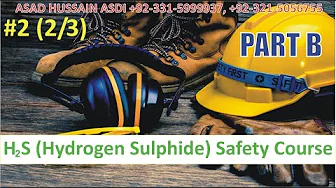IASP / NASP Hazard Communication Course In Pakistan (Rawalpindi, Peshawar)
IASP / NASP Hazard Communication Course
In an ever-evolving world where safety and risk management play pivotal roles, the importance of effective hazard communication cannot be overstated. Understanding the intricacies of hazardous materials and their potential risks is crucial for maintaining workplace safety standards. This is where courses like the IASP/NASP Hazard Communication Course come into play, offering comprehensive training to professionals seeking to enhance their knowledge and skills in this vital area.
Course Overview:
The IASP/NASP Hazard Communication Course is designed to provide participants with a thorough understanding of hazard communication principles, regulations, and best practices. From chemical labeling to safety data sheets (SDS) and employee training, the course covers a wide range of topics essential for ensuring workplace safety and compliance with regulatory standards.
Course Benefits:
- Enhanced Safety Awareness: By completing this course, participants gain a deeper understanding of hazardous materials and their associated risks, allowing them to identify potential hazards more effectively.
- Regulatory Compliance: The course helps organizations ensure compliance with hazard communication standards set forth by regulatory bodies such as OSHA (Occupational Safety and Health Administration) and other relevant authorities.
- Improved Risk Management: Armed with knowledge gained from the course, professionals can implement robust risk management strategies to mitigate the potential impact of hazardous materials in the workplace.
- Career Advancement: Certification in hazard communication demonstrates a commitment to safety and professional development, potentially opening doors to career advancement opportunities within various industries.
- Enhanced Workplace Culture: Investing in employee training fosters a culture of safety within organizations, promoting employee well-being and productivity.
Study Units:
The course curriculum is divided into comprehensive study units, each focusing on different aspects of hazard communication. Some of the key study units include:
- Introduction to Hazard Communication: An overview of the importance of hazard communication, relevant regulations, and key terminology.
- Hazardous Chemicals: Identification and classification of hazardous chemicals, including their physical and health hazards.
- Safety Data Sheets (SDS): Understanding the purpose and content of SDS, and how to effectively utilize them in the workplace.
- Chemical Labeling: Guidelines for proper chemical labeling, including requirements for hazard symbols, signal words, and precautionary statements.
- Employee Training: Strategies for conducting effective hazard communication training for employees, including methods for ensuring comprehension and retention.
- Emergency Response: Protocols for responding to chemical emergencies, including spill response procedures and evacuation plans.
Learning Outcomes:
Upon completion of the IASP/NASP Hazard Communication Course, participants can expect to achieve the following learning outcomes:
- Ability to identify and assess hazardous chemicals in the workplace.
- Proficiency in interpreting safety data sheets (SDS) and chemical labels.
- Competence in implementing hazard communication programs that comply with regulatory standards.
- Skills to effectively communicate hazard information to employees and other stakeholders.
- Understanding of emergency response protocols for chemical incidents.
- Awareness of best practices for managing risks associated with hazardous materials.
Who is this Course For:
The IASP/NASP Hazard Communication Course is suitable for a wide range of professionals across various industries, including but not limited to:
- Safety Managers and Coordinators: Individuals responsible for overseeing safety protocols and compliance within their organizations.
- Environmental Health and Safety (EHS) Professionals: Those involved in identifying, assessing, and managing environmental and occupational health hazards.
- Facility Managers: Personnel tasked with ensuring the safety and well-being of employees within workplace facilities.
- Chemical Handlers and Technicians: Workers involved in the handling, storage, and transportation of hazardous chemicals.
- Occupational Health Nurses: Healthcare professionals responsible for promoting workplace health and safety.
- Regulatory Compliance Officers: Professionals responsible for ensuring that organizations adhere to relevant safety regulations and standards.
Future Progression:
Completing the IASP/NASP Hazard Communication Course is just the beginning of a journey toward continuous improvement in workplace safety and risk management. Graduates of the course may consider pursuing further education or certification in related fields, such as:
- Advanced Safety Certifications: Building upon the foundational knowledge gained from the Hazard Communication Course, professionals can pursue advanced certifications in areas such as industrial hygiene, process safety management, or hazardous materials management.
- Specialized Training Programs: Depending on their specific industry or job role, individuals may benefit from specialized training programs focusing on topics such as chemical safety, emergency response, or environmental management.
- Continuing Education: Staying updated on changes in regulations, emerging technologies, and best practices is essential in the field of hazard communication. Professionals can engage in ongoing education through seminars, workshops, and online courses to expand their knowledge and skills.
- Leadership Development: As professionals gain experience and expertise in hazard communication, they may explore opportunities to take on leadership roles within their organizations, such as safety directors or environmental health managers.
In a world where workplace safety is paramount, the IASP/NASP Hazard Communication Course equips professionals with the knowledge and skills needed to navigate the complexities of hazardous materials effectively. By understanding the principles of hazard communication, complying with regulatory standards, and implementing best practices, organizations can create safer and healthier work environments for their employees. Investing in hazard communication training not only mitigates risks but also demonstrates a commitment to fostering a culture of safety and well-being. As industries evolve and new challenges emerge, continuous education and professional development will remain essential for staying ahead of the curve and ensuring the highest standards of workplace safety.
****** For Registration & Information ******
For Free Video Lectures Click Here











